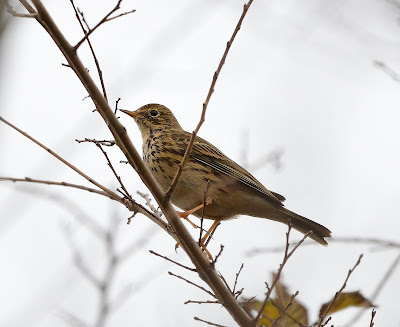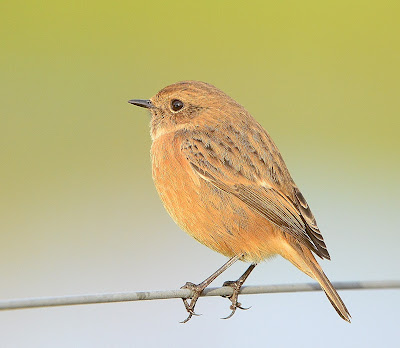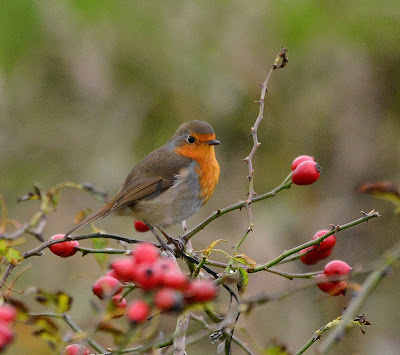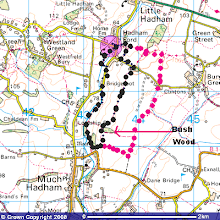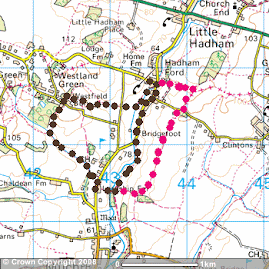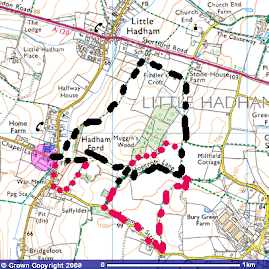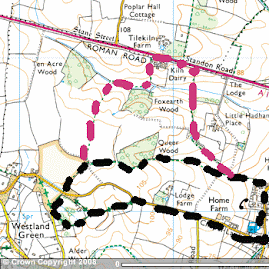Last Wednesday (14th October) there were easterlies blowing over the North Sea along with heavy rain. Perfect conditions for forcing migrants to seek shelter and as Friday was a free day, I set off just after 5am for another day based around Wells Next the Sea.
My usual coffee and snack at Wells Co-Op and then along to Garden Drove, some 3 miles east of Wells. Along the very muddy track before parking near the pig fields and down the track which emerges on Warham Greens. A covey of young Grey partridges greeted my arrival as I changed into my walking boots, collected the camera and binoculars and was off. Everything and anything was possible here so each tree was checked along the 600 yard track. Goldcrests in their 100's! A sycamore and adjacent oak was absolutely swarming with them but the light was not good enough so I planned to get some snaps as I returned to the car.
On to the Coastal Footpath and headed west towards Wells. Thrush species in good number: Fieldfare (a few,) Redwing (loads,) Scandinavian blackbirds showing their all black bill (100's) along with a few rattling Mistle thrushes and a solitary Song thrush. Goldfinches and linnets also in good sized flocks whilst out on the Greens: Brent geese, Little egrets, Redshanks and curlews along with Black headed gulls a plenty. A good start. Flocks of Skylarks overhead and further inland the constant sound of Pink footed geese. Wrens alarm called, Robins sang and a very brief view of a Ring ouzel, my first of the season, its silvery wings distinguishing it from the numerous blackbirds.
After about a mile, I decided to head back and there was nothing new appearing. I checked a well known hollow, full of brambles but just thrush sp, reed buntings and finches. I arrived back at Garden Drove to note a few more goldcrests hovering over and under leaves. Always a chance of a Siberian warbler species in with them and it wasn't long before I caught sight of a larger bird with bright yellow over the eye, a Yellow browed warbler. This bird breeds upon the Siberian Taiga. First of 3 that I found.
Back to the main flock of goldcrests that appeared to have grown in number. All very active and busy feeding, so much so they often came too close for the camera to focus. Again, I checked through them for anything else, but nothing was apparent. A superb sight, the most I have ever come across in such a small area. Needless to say, I fired off many photos in still grey light. I messed around with manual settings and a few came out reasonably well lit but many did not!
A flock of wigeon headed west as I arrived back at the car, already suitably pleased and rather muddy.
 |
| Grey partridge |
 |
| Pied wagtail |
 |
| Pink foots |
 |
| Linnets |
 |
| Song thrush, note arrow head shaped spots that helps distinguish from Mistle thrush |
 |
| Scandinavian/Siberian blackbird showing black bill |
 |
| Feeding frenzy of Goldfinches |
 |
| Goldcrest |
 |
| Male goldcrest showing orange crown |
 |
| Goldcrests were never still! |
 |
| Female goldcrest showing yellow crown |
 |
| The wingbar here helps search out yellow browed warbler as they have two bars |
 |
| Checking for insects and spiders |
 |
| This sycamore leaf gives an indication of how small this female is |
 |
| Great expression from this female |
 |
| Wigeon flock heading west |
I now headed off to Wells Woods and stumped up a rather extortionate £3.50 for two hours of parking at the beach car park. I headed towards the Dell but by the time I arrived there it was clearly apparent that there were few, if any migrants present. In fact there were hardly any birds: Great tits, Long tailed tits, wrens, Blue tits and Robins along with an overhead kestrel. These were expensive birds! A yellow browed warbler called from a distant birch, proving too fast for the camera and a female blackcap sat atop a bramble pile. I continued to check the bushes but very little to be found so, having checked the boating lake where Little grebe got on to the day list I was back at the car after 45 minutes.
 |
| Little grebe |
 |
| Definite sign of few birds if you resort to photographing Grey squirrels! |
I now headed to Lady Anne's Drive opposite the Victoria hotel at Holkham. Same price structure for parking here so another £3.50 and off I went. A Great white egret flew over before landing in a ditch at distance whilst Grey lag geese, Egyptian geese, wigeon, lapwings and a few curlews probed the muddy pastures. A Wall butterfly roosted on a car hubcap.
Into Holkham pines and headed west. Again, very little apart from goldcrests again. I stopped to check through this very mobile flock but just another Yellow browed so I moved further west. Just before the Jordan tower hide another fall of goldcrests in an oak. Surely this time I would get something else, a Firecrest perhaps, but no, better than that. Right at the back, feeding rapidly in a birch a bird slightly larger than goldcrest but showing a yellow crown stripe but with 2 broad yellow eye stripes, too and a pair of wingbars, a Pallas's warbler. I watched it hover over leaves much like a goldcrest whereupon the yellow rump was visible, sealing the id. Another Siberian taiga bird brought over by the easterlies. I fired of photos but the light was so poor and the bird so fast that it was pointless.
Photo here from the internet to get an idea what this wonderful sprite looks like. Not a regular bird for the UK, just my 5th ever and all from Holkham and Wells Woods
By now my time was close to expiring and I know how diligent the car park attendants are along here so back to the car and off to my final destination of the day.
 |
| Distant great white egret |
 |
| Incoming Greylags |
 |
| Unusual roost for a Wall butterfly |
 |
| Greylag |
 |
| Pink foots |
 |
| Pallas's warbler (not my photo) |
I parked opposite a path that leads to the dunes some 2 miles out from Burnham Overy Staithe and set off again, checking hedges. A chiffchaff called its autumn wheet wheet call and in neighbouring fields plenty of geese. Meadow pipits greeted me on the old sea defence wall, not the coastal footpath and over the mud flats plenty of redshanks probed. Huge parties of linnets and goldfinches as I started to check bushes around Gun Hill but, as last time I was there, very little to be found so I headed back to the board walk for the 1.5 mile walk back east towards Holkham Pines. Far across the fields a Short Eared owl sat on the ground, another season's first and plenty of stonechat on top of brambles.
Just before entering into the pines, not 400 yards from where I hade been near the Jordan tower hide, there is well known hollow which is overgrown with brambles and plenty of cover for skulking migrants. Several other birders were already present but there was plenty of room for us all so I was content being there. A Barred warbler had been seen earlier in the day as well as a Siberian stonechat. The Barred warbler is a bird that usually stays well hidden in deep vegetation as is often found on call rather than sight. After a few minutes a rounded grey bird popped up, took a berry and was gone. That was the view for the next 20 minutes before it showed a couple more times. By now, it was useless light but I fired away more in hope than expectation. The results speak for themselves.
No sign of the unusual stonechat but in a field of Belted Galloway cattle, a grey heron and a pair of cattle egrets. One of the egrets was feeding upon a frog. Huge numbers of cormorant were coming into roost, often in parties of 35+ and the pink foots were heading off to their night time roost as well. I headed back to the car in the gathering gloom having had another great day. So many birds within just a few miles of Wells and no need to visit a busy bird reserve. I had covered over 10 miles on foot. Before finishing I managed a few grey photos of dunlin on the mud but sadly, by the time I got a reasonable view of the hunting Short eared owl it was just too dark to bother. Another day for this species.
 |
| Wading redshank |
 |
| A very strange and short lived light over the dunes |
 |
| Greylags |
 |
| Feeding goldfinch |
 |
| More goldfinches |
 |
| Loads of linnets, 1 Goldfinch |
 |
| Best I could manage of the distant and elusive Barred warbler |
 |
| No sooner seen, than gone! |
 |
| Grey heron using the Belted Galloways to disturb its prey |
 |
| Cattle egret with frog |
 |
| Cormorants off to roost |
 |
Golden plover flock
|
 |
| Cormorant in rapidly darkening sky |
 |
| Feeding dunlin |
 |
| Last photo of the day, Pink footed geese. |
Species list
- Little grebe
- Cormorant
- Cattle egret
- Little egret
- Great white egret
- Grey heron
- Mute swan
- Pink footed goose
- Greylag goose
- Canada goose
- Brent goose
- Shelduck
- Egyptian goose
- Mallard
- Gadwall
- Wigeon
- Teal
- Marsh harrier
- Red kite
- Common buzzard
- Kestrel
- Peregrine falcon
- Grey partridge
- Red legged partridge
- Pheasant
- Moorhen
- Coot
- Golden plover
- Lapwing
- Dunlin
- Redshank
- Curlew
- Snipe
- Black headed gull
- Herring gull
- Lesser black backed gull
- Wood pigeon
- Collared dove
- Short eared owl
- Green woodpecker
- Great spotted woodpecker
- Skylark
- Meadow pipit
- Pied wagtail
- Wren
- Dunnock
- Robin
- Stonechat
- Song thrush
- Mistle thrush
- Fieldfare
- Redwing
- Blackbird
- Ring ouzel
- Blackcap
- Chiffchaff
- Barred warbler
- Cetti's warbler (heard)
- Yellow browed warbler
- Pallas's warbler
- Goldcrest
- Great tit
- Coal tit
- Blue tit
- Long tailed tit
- Bearded reedling (Heard)
- Nuthatch
- Magpie
- Jay
- Jackdaw
- Rook
- Carrion crow
- Starling
- House sparrow
- Chaffinch
- Goldfinch
- Linnet
- Greenfinch
- Reed bunting
 |
| Yet another Goldcrest, female |

